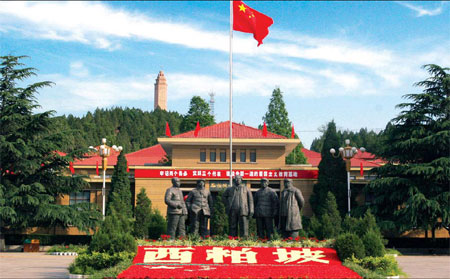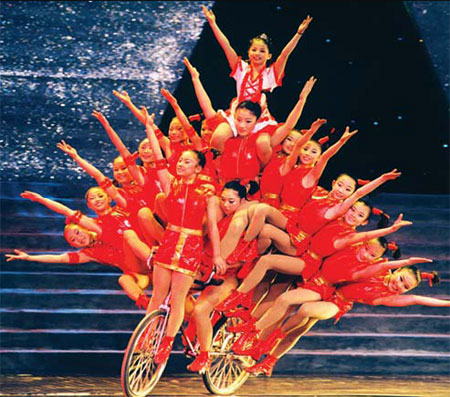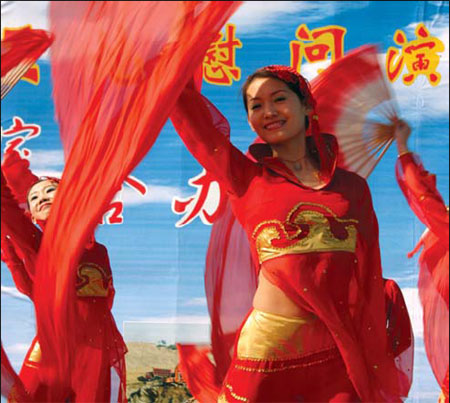|

Xibaipo, about 90 km from the provincial capital, Shijiazhuang, is where the Central Committee of the Communist Party of China had its headquarters before liberation in 1949.
|
|

Acrobatic show staged by local performers.
|
|

People promote a rich and diversified cultural life in Hebei.
|
Movies are big business in Hebei province, and many of its moviemakers and cinemas have been in the restructuring process, along with various publishers and artists.
The movie After Shock, based on the Tangshan earthquake in Hebei, in 1976, was a big box-office hit last year, pulling in nearly 700 million yuan ($107.7 million) in receipts, while setting a benchmark for the province's culture business.
And the restructuring has paid off: Profits of the Hebei Publishing Media Group were up more than 40 percent last year, while revenues of provincial art troupes increased 32 percent.
The Hebei Daily Newspaper Group made 600 million yuan, up 16.5 percent from 2009.
The province counts the Great Wall, Taihang Mountains, and Bohai Bay among its most important symbols and its movies, TV series, folk dramas and books have done quite well.
The novel "Soldiers Sortie", and a TV adaptation of the same name, caused quite a sensation, with nearly 280,000 copies being sold nationwide, bringing in 9 million yuan.
"Last year, Hebei's culture industry produced the largest quantity of fine works, with the greatest influence and largest profits," said a provincial culture official.
The Quyang Hongzhou Marble Arts Co Ltd, a handicrafts manufacturer, has seen annual sales grow to more than 100 million yuan.
The county of Yixian has an ink-stone manufacturing chain with nearly 20,000 employees and an annual output value of around 200 million yuan.
The county of Wuqiang has more than 5,000 people engaged in the New Year's painting industry, with annual sales amounting to 350 million yuan.
It is also a major musical instrument producer, employing more than 4,000 people and assets worth 200 million yuan.
The provincial government is planning some major cultural projects, with at least 100 billion yuan in backing, and a number of which started last year.
For its 12th Five-Year Plan (2011-2015), it plans to build more museums and libraries, and encourage more culture business reforms.
It also wants to do more to protect heritage sites, such as the Chengde summer resort and its outlying temples, which are recognized as a UNESCO World Heritage site.
The province also has plans for key projects in next-generation radio and TV networks, a national animation center in the city of Baoding, and a ski and tourism base in Chongli county.
The culture industry thinks it can contribute more than 5 percent to provincial GDP by 2015, and have an average growth rate of more than 20 percent in the next five years.
Culture is also being promoted in the countryside, where more than 12,000 libraries have been built, and many government offices and companies have donated around 5 million books.
An additional 10,000 libraries are planned for the near future.
Provincial offices have organized drama, music, and other art performances for the countryside. Langfang's Dachang Song and Dance Group is now a national model of grassroots work, and, last year, gave 210 performances and generated 8 million yuan in profits.
The folk handicrafts business is also being encouraged, such as the stone carvings of Quyang county, paper-cuts of Weixian county, elaborate painting of Ningjin county, and the paintings of Hengshui city - where pictures are put inside semitransparent glass or crystal objects so they are visible from outside.
(China Daily 10/27/2011 page6)




